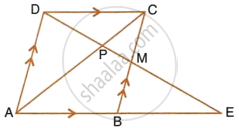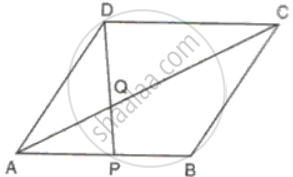Advertisements
Advertisements
प्रश्न
In the following figure, M is mid-point of BC of a parallelogram ABCD. DM intersects the diagonal AC at P and AB produced at E. Prove that : PE = 2 PD

उत्तर
In ΔBME and ΔDMC,
∠BME = ∠CMD ...(Vertically opposite angles)
∠MCD = ∠MBE ...(Alternate angles)
BM = MC ...(M is the mid-point of BC)
So, ΔBME ≅ ΔDMC ...(AAS congruence criterion)
`=>` BE = DC = AB
In ΔDCP and ΔEPA,
∠DPC = ∠EPA ...(Vertically opposite angles)
∠CDP = ∠AEP ...(Alternate angles)
ΔDCP ∼ ΔEAP ...(AA criterion for similarity)
`=> (DC)/(EA) = (PC)/(PA) = (PD)/(PE)`
`=> (EA)/(DC) = (PE)/(PD)`
`=> (PE)/(PD) = (AB + BE)/(DC)`
`=> (PE)/(PD) = (2DC)/(DC)`
`=> (PE)/(PD) = 2`
`=>` PE = 2PD
APPEARS IN
संबंधित प्रश्न
In figure, ∆ACB ~ ∆APQ. If BC = 8 cm, PQ = 4 cm, BA = 6.5 cm, AP = 2.8 cm, find CA and AQ.
In figure, considering triangles BEP and CPD, prove that BP × PD = EP × PC.
ABC is a triangle. PQ is a line segment intersecting AB in P and AC in Q such that PQ || BC and divides triangle ABC into two parts equal in area. Find the value of ratio BP : AB.
The areas of two similar triangles are `64cm^2` and `100cm^2` respectively. If a median of the smaller triangle is 5.6cm, find the corresponding median of the other.
A ship is 400m laig and 100m wide. The length of its model is 20 cm. find the surface area of the deck of the model.
In ΔABC, MN is drawn parallel to BC. If AB = 3.5cm, AM : AB = 5 : 7 and NC = 2cm, find:
(i) AM
(ii) AC
The diagonal AC of a parallelogram ABCD intersects DP at the point Q, where P is any point on side AB. Prove that CQ x PQ = QA x QD.
ΔXYZ is enlarged to ΔX'Y'Z'. If XY = 12cm, YZ = 8cm and XZ = 14cm and the smallest side of ΔX'Y'Z' is 12cm, find the scale factor and use it to find the length of the other sides of the image ΔX'Y'Z'.
A model of cargo tuck is made to a scale of 1:40. The length of the model is 15cm. Calculate: The volume of the model if the volume of the truck is 6m3
If ∆ABC is an isosceles triangle with ∠C = 90° and AC = 5 cm, then AB is
